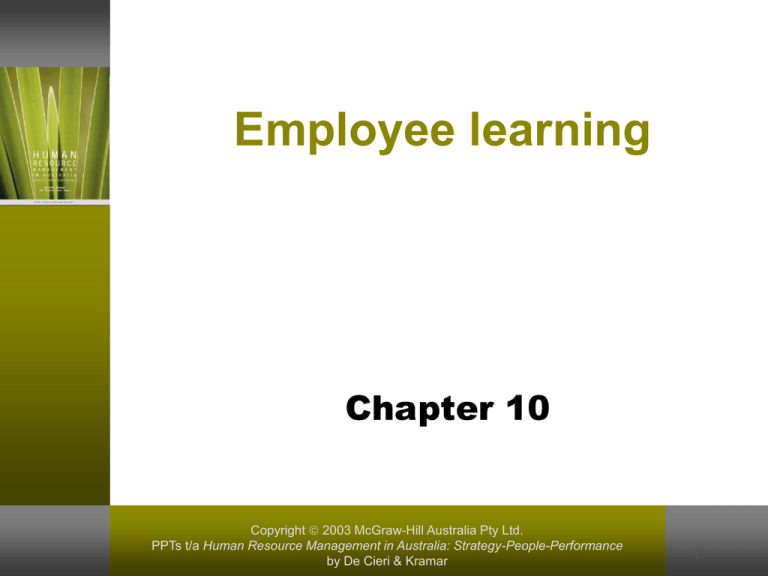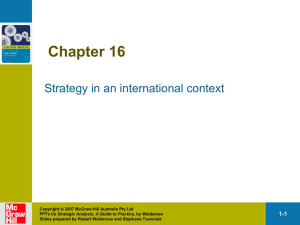Chapter 10
advertisement

Employee learning Chapter 10 Copyright 2003 McGraw-Hill Australia Pty Ltd. PPTs t/a Human Resource Management in Australia: Strategy-People-Performance by De Cieri & Kramar 1 Employee learning Objectives Discuss how training can help companies gain a competitive advantage. Explain how to conduct a needs assessment. Explain how to evaluate employees’ readiness for training. Discuss the strengths and weaknesses of presentation, hands-on and group-building training methods. Copyright 2003 McGraw-Hill Australia Pty Ltd. PPTs t/a Human Resource Management in Australia: Strategy-People-Performance by De Cieri & Kramar 10-2 Employee learning Objectives (continued) Explain the potential advantages of new technologies for training. Design a training session to maximise learning. Explain how to choose an appropriate evaluation design. Discuss socialisation and orientation processes. Copyright 2003 McGraw-Hill Australia Pty Ltd. PPTs t/a Human Resource Management in Australia: Strategy-People-Performance by De Cieri & Kramar 10-3 Employee learning (also learning, or training) A planned effort by a company to facilitate employees’ learning of job-related competencies. Competencies include knowledge, skills or behaviours that are critical for successful job performance. Copyright 2003 McGraw-Hill Australia Pty Ltd. PPTs t/a Human Resource Management in Australia: Strategy-People-Performance by De Cieri & Kramar 10-4 Why is training important? Increases employees’ knowledge of foreign competitors and cultures. Provides the skills required to work with new technology. Helps employees understand how to work effectively in teams. Ensures that the company’s culture emphasises innovation, creativity and learning. Ensures employment security by providing new ways for employees to contribute to the company. Prepares employees to accept each other and work more effectively together, particularly in a diverse workforce. Copyright 2003 McGraw-Hill Australia Pty Ltd. PPTs t/a Human Resource Management in Australia: Strategy-People-Performance by De Cieri & Kramar 10-5 Intellectual capital Training should be viewed as a way to create intellectual capital. Intellectual capital includes basic skills, advanced skills, an understanding of the customer or manufacturing system, and self-motivated creativity. Intellectual capital is created through a process of combining the knowledge and experience of different parties and exchange between the parties. Copyright 2003 McGraw-Hill Australia Pty Ltd. PPTs t/a Human Resource Management in Australia: Strategy-People-Performance by De Cieri & Kramar 10-6 High-leverage training strategy Is linked to strategic business goals and objectives. Uses an instructional design process to ensure that training is effective. Compares or benchmarks the company’s training programs against training programs in other companies. Is a characteristic of a ‘learning organisation’. Copyright 2003 McGraw-Hill Australia Pty Ltd. PPTs t/a Human Resource Management in Australia: Strategy-People-Performance by De Cieri & Kramar 10-7 Learning organisations Employees continuously attempt to learn new things and apply what they have learned to improve product or service quality. An organisation that has an enhanced capacity to learn, adapt and change. In a learning organisation, training is seen as one part of a system designed to create intellectual capital. Copyright 2003 McGraw-Hill Australia Pty Ltd. PPTs t/a Human Resource Management in Australia: Strategy-People-Performance by De Cieri & Kramar 10-8 Components of instructional design Conducting needs assessment Ensuring employees’ readiness for training Creating a learning environment Ensuring transfer of training Selecting training methods Evaluating training programs See Table 10.2 for more detail Copyright 2003 McGraw-Hill Australia Pty Ltd. PPTs t/a Human Resource Management in Australia: Strategy-People-Performance by De Cieri & Kramar 10-9 Figure 10.1 The needs assessment process Copyright 2003 McGraw-Hill Australia Pty Ltd. PPTs t/a Human Resource Management in Australia: Strategy-People-Performance by De Cieri & Kramar 10-10 Organisational analysis Organisational analysis involves considering the context in which training will occur. Three factors need to be considered before choosing training as the solution to any pressure point: Support of managers and peers for training activities Company strategy Training resources available. Copyright 2003 McGraw-Hill Australia Pty Ltd. PPTs t/a Human Resource Management in Australia: Strategy-People-Performance by De Cieri & Kramar 10-11 Person analysis Person analysis helps to identify who needs training. Person analysis involves: Determining whether performance deficiencies result from a lack of knowledge, skill or ability (a training issue) or from a motivational or work-design problem Identifying who needs training Determining employee’s readiness for training. Copyright 2003 McGraw-Hill Australia Pty Ltd. PPTs t/a Human Resource Management in Australia: Strategy-People-Performance by De Cieri & Kramar 10-12 Person analysis Factors that influence employee performance and learning: Personal characteristics Input Output Consequences Feedback Copyright 2003 McGraw-Hill Australia Pty Ltd. PPTs t/a Human Resource Management in Australia: Strategy-People-Performance by De Cieri & Kramar 10-13 Task analysis Identifying the important tasks and knowledge, skills and behaviours that need to be emphasised in training, in order for employees to complete their tasks. Copyright 2003 McGraw-Hill Australia Pty Ltd. PPTs t/a Human Resource Management in Australia: Strategy-People-Performance by De Cieri & Kramar 10-14 Task analysis Four steps: Select the job to be analysed. Develop a preliminary list of tasks performed on the job. Validate or confirm the preliminary list of tasks. Once the tasks are confirmed, identify the knowledge, skills or abilities necessary to successfully perform each task. Copyright 2003 McGraw-Hill Australia Pty Ltd. PPTs t/a Human Resource Management in Australia: Strategy-People-Performance by De Cieri & Kramar 10-15 Readiness for training Employees have the personal characteristics (ability, attitudes, beliefs, and motivation) necessary to learn program content and apply it on the job. The work environment will facilitate learning and will not interfere with performance. Copyright 2003 McGraw-Hill Australia Pty Ltd. PPTs t/a Human Resource Management in Australia: Strategy-People-Performance by De Cieri & Kramar 10-16 How can managers ensure employee readiness for training? Ensure employees’ self-efficacy. Understand the benefits of training. Be aware of training needs, career interests and goals. Understand work environment characteristics. Ensure employees’ basic skills levels. Also consider input, output, consequences and feedback. Copyright 2003 McGraw-Hill Australia Pty Ltd. PPTs t/a Human Resource Management in Australia: Strategy-People-Performance by De Cieri & Kramar 10-17 Creating a learning environment Employees need to: Know why they should learn Use their own experiences as a basis for learning Have opportunities to practise Receive feedback Learn by observing and interacting with others Undergo a well coordinated and arranged training program. Copyright 2003 McGraw-Hill Australia Pty Ltd. PPTs t/a Human Resource Management in Australia: Strategy-People-Performance by De Cieri & Kramar 10-18 Figure 10.3 Transfer of training Copyright 2003 McGraw-Hill Australia Pty Ltd. PPTs t/a Human Resource Management in Australia: Strategy-People-Performance by De Cieri & Kramar 10-19 Selecting training methods Presentation methods Classroom instruction Distance learning Audiovisual techniques Copyright 2003 McGraw-Hill Australia Pty Ltd. PPTs t/a Human Resource Management in Australia: Strategy-People-Performance by De Cieri & Kramar 10-20 Selecting training methods Hands-on methods On-the-job training (OJT) Self-directed learning Apprenticeship Simulations Business games and case studies Behaviour modelling Interactive video E-learning Copyright 2003 McGraw-Hill Australia Pty Ltd. PPTs t/a Human Resource Management in Australia: Strategy-People-Performance by De Cieri & Kramar 10-21 Selecting training methods Group-building methods Adventure learning Team training Action learning Copyright 2003 McGraw-Hill Australia Pty Ltd. PPTs t/a Human Resource Management in Australia: Strategy-People-Performance by De Cieri & Kramar 10-22 Evaluating training programs Training outcomes: Cognitive outcomes Skill-based outcomes Affective outcomes Results Return on investment (ROI) Copyright 2003 McGraw-Hill Australia Pty Ltd. PPTs t/a Human Resource Management in Australia: Strategy-People-Performance by De Cieri & Kramar 10-23 Reasons for evaluating training To identify the program’s strengths and weaknesses. To assess whether the content, organisation and administration of the program contribute to learning and the use of training content on the job. To identify which trainees benefited most or least from the program. To gather data to assist in marketing programs. To determine the financial benefits and costs of the program. To compare the costs and benefits of training versus non-training investments. To compare the costs and benefits of different training programs, so as to choose the best program. Copyright 2003 McGraw-Hill Australia Pty Ltd. PPTs t/a Human Resource Management in Australia: Strategy-People-Performance by De Cieri & Kramar 10-24 Evaluation designs Pre-test/post-test with comparison group Pre-test/post-test Post-test only Time series Copyright 2003 McGraw-Hill Australia Pty Ltd. PPTs t/a Human Resource Management in Australia: Strategy-People-Performance by De Cieri & Kramar 10-25 Socialisation and orientation Organisational socialisation: The process by which new employees are transformed into effective members of a company. Three phases: Anticipatory socialisation Encounter Settling in Copyright 2003 McGraw-Hill Australia Pty Ltd. PPTs t/a Human Resource Management in Australia: Strategy-People-Performance by De Cieri & Kramar 10-26 Orientation programs (see Table 10.9 for more detail) Content of orientation programs Company-level information Department-level information Miscellaneous Copyright 2003 McGraw-Hill Australia Pty Ltd. PPTs t/a Human Resource Management in Australia: Strategy-People-Performance by De Cieri & Kramar 10-27 Table 10.10 Characteristics of effective orientation programs Employees are encouraged to ask questions. Program includes information on both technical and social aspects of the job. Orientation is the responsibility of the new employee’s manager. Debasement and embarrassment of new employees is avoided. Formal and informal interactions with managers and peers occur. Programs involve relocation assistance. Employees are provided with information about the company’s products, services and customers. Copyright 2003 McGraw-Hill Australia Pty Ltd. PPTs t/a Human Resource Management in Australia: Strategy-People-Performance by De Cieri & Kramar 10-28 Summary Many companies are using new technology to give employees control of their learning and career development. A systematic approach to training has been presented. The key to successful training is to choose a method that will best accomplish the training objectives. Training can contribute to effectiveness through establishing a link with the company’s strategic direction, and demonstrating return on investment. Copyright 2003 McGraw-Hill Australia Pty Ltd. PPTs t/a Human Resource Management in Australia: Strategy-People-Performance by De Cieri & Kramar 10-29








